Recent Advances in Computational Modeling of Primary Atomization of Liquid Fuel Sprays
Abstract
1. Introduction
2. Conventional Spray Simulation Approaches
2.1. Overall Structures of A Spray
2.2. DNS, RANS and LES
2.3. Computational Approaches for the Dilute Spray Region
2.4. Conventional Computational Approaches for the Dense Spray Region
3. Understanding Primary Atomization by DNS and Experiments
4. Recent Modeling Approaches for Practical Scale Primary Atomization Simulations
4.1. Hybrid Eulerian DNS and Lagrangian Method
4.2. Eulerian–Lagrangian Spray Atomization (ELSA) Model
4.3. PDF SGS Turbulent Atomization Model
4.4. Hybrid Eulerian–Lagrangian LES Approach
4.5. Hybrid Eulerian–Lagrangian LES with Self-Closed SGS Turbulent Atomization Model
5. Summary
Funding
Conflicts of Interest
Nomenclature
| Alphabetical symbols | |
| radius | |
| constant for turbulence (=5.57 in Section 4.5) | |
| Bond number | |
| drag coefficient | |
| , | empirical constants for model (in Section 4.4) |
| coefficient for modeling equilibrium interface area per unit volume (in Section 4.3) | |
| diameter | |
| subgrid-scale diffusivity | |
| Sauter mean diameter | |
| drag force for droplet | |
| surface deceleration | |
| size of the integration kernel (in Section 4.3) | |
| distance of LES-resolved surface from the eddy center (in Section 4.5) | |
| kinetic energy | |
| characteristic length | |
| turbulent length scale (in Section 4.4) | |
| reference turbulent eddy scale (in Section 4.5) | |
| mass | |
| component of surface normal vector | |
| liquid core surface regression due to atomization (in Section 4.5) | |
| subgrid-scale joint probability density function | |
| Reynolds number | |
| source term | |
| Stokes number | |
| time | |
| characteristic velocity | |
| , | velocity |
| velocity fluctuation | |
| Weber number | |
| position | |
| grid spacing | |
| Greek symbols | |
| wavenumber | |
| extensional eigenvalue of strain tensor (in Section 2.3) | |
| intermediate eigenvalue of strain tensor (in Section 2.3) | |
| compressive eigenvalue of strain tensor (in Section 2.3) | |
| dissipation rate | |
| Taylor microscale (in Section 4.4) | |
| wavelength (in Section 4.5) | |
| viscosity | |
| kinematic viscosity | |
| density | |
| interface area per unit volume | |
| surface tension coefficient | |
| relaxation time scale | |
| Stokes time scale | |
| liquid volume fraction | |
| surface density function | |
| Subscripts | |
| d | droplet |
| dest | destruction |
| eq | equilibrium |
| G | gas |
| gen | generation |
| inj | injection |
| L | liquid |
| lig | ligament |
| m | most unstable |
| nozzle | nozzle |
| Superscripts | |
| - | averaged |
| ^ | spatially filtered |
| ~ | Favre-averaged |
| * | resonant |
References
- International Organization of Motor Vehicle Manufacturers. Available online: http://www.oica.net/category/sales-statistics/ (accessed on 2 September 2018).
- Sirignano, W.A. Fluid Dynamics and Transport of Droplets and Sprays, 2nd ed.; Cambridge University Press: Cambridge, UK, 2010. [Google Scholar]
- Faeth, G.M. Spray combustion phenomena. Proc. Combust. Inst. 1996, 26, 1593–1612. [Google Scholar] [CrossRef]
- Linne, M. Imaging in the optically dense regions of a spray: A review of developing techniques. Prog. Energy Combust. Sci. 2013, 39, 403–440. [Google Scholar] [CrossRef]
- Engine Combustion Network. Sandia National Laboratories. Available online: https://ecn.sandia.gov/ (accessed on 12 October 2018).
- Reitz, R.D.; Rutland, C.J. Development and testing of diesel engine CFD models. Prog. Energy Combust. Sci. 1995, 21, 173–196. [Google Scholar] [CrossRef]
- Gorokhovski, M.; Herrmann, M. Modeling primary atomization. Annu. Rev. Fluid Mech. 2008, 40, 343–366. [Google Scholar] [CrossRef]
- Jiang, X.; Siamas, G.A.; Jagus, K.; Karayiannis, T.G. Physical modelling and advanced simulations of gas-liquid two-phase jet flows in atomization and sprays. Prog. Energy Combust. Sci. 2010, 36, 131–167. [Google Scholar] [CrossRef]
- Subramaniam, S. Lagrangian-Eulerian methods for multiphase flows. Prog. Energy Combust. Sci. 2013, 39, 215–245. [Google Scholar] [CrossRef]
- Kolakaluri, R.; Subramaniam, S.; Panchagnula, M.V. Trends in multiphase modeling and simulation of sprays. Int. J. Spray Combust. Dyn. 2014, 6, 317–356. [Google Scholar] [CrossRef]
- Fujimoto, H. (Mazda Research and Development Divisions). Personal communication, 2017.
- Miller, R.S.; Bellan, J. Direct numerical simulation of a confined three-dimensional gas mixing layer with one evaporating hydrocarbon-droplet-laden stream. J. Fluid Mech. 1999, 384, 293–338. [Google Scholar] [CrossRef]
- Sankaran, V.; Menon, S. Vorticity-scalar alignments and small-scale structures in swirling spray combustion. Proc. Combust. Inst. 2002, 29, 577–584. [Google Scholar] [CrossRef]
- Umemura, A.; Shinjo, J. Toward a new paradigm of spray combustion research. In Proceedings of the 9th Asia-Pacific Conference on Combustion, Gyeongju, Korea, 19–22 May 2013. [Google Scholar]
- Sher, E.; Bar-Kohany, T.; Rashkovan, A. Flash-boiling atomization. Prog. Energy Combust. Sci. 2008, 34, 417–439. [Google Scholar] [CrossRef]
- Sovani, S.D.; Sojka, P.E.; Lefebvre, A.H. Effervescent atomization. Prog. Energy Combust. Sci. 2001, 27, 483–521. [Google Scholar] [CrossRef]
- Brennen, C.H. Cavitation and Bubble Dynamics; Oxford University Press: Oxford, UK, 1995. [Google Scholar]
- Sou, A.; Biçer, B.; Tomiyama, A. Numerical simulation of incipient cavitation flow in a nozzle of fuel injector. Comput. Fluids 2014, 103, 42–48. [Google Scholar] [CrossRef]
- Bellan, J. Supercritical (and subcritical) fluid behavior and modeling: Drops, streams, shear and mixing layers, jets and sprays. Prog. Energy Combust. Sci. 2000, 26, 329–366. [Google Scholar] [CrossRef]
- Lacaze, G.; Misdariis, A.; Ruiz, A.; Oefelein, J.C. Analysis of high-pressure Diesel fuel injection processes using LES with real-fluid thermodynamics and transport. Proc. Combust. Inst. 2015, 35, 1603–1611. [Google Scholar] [CrossRef]
- Jalaal, M.; Mehravaran, K. Fragmentation of falling liquid droplets in bag breakup mode. Int. J. Multiph. Flow 2012, 47, 115–132. [Google Scholar] [CrossRef]
- Sallam, K.A.; Dai, D.; Faeth, G.M. Liquid breakup at the surface of turbulent round liquid jets in still gases. Int. J. Multiph. Flow 2002, 28, 427–449. [Google Scholar] [CrossRef]
- Shinjo, J.; Umemura, A. Simulation of liquid jet primary breakup: Dynamics of ligament and droplet formation. Int. J. Multiph. Flow 2010, 36, 513–532. [Google Scholar] [CrossRef]
- Poinsot, T.; Veynante, D. Theoretical and Numerical Combustion, 2nd ed.; Edwards: Irvine, CA, USA, 2005. [Google Scholar]
- Burton, T.M.; Eaton, J. Fully resolved simulations of particle-turbulence interaction. J. Fluid Mech. 2005, 545, 67–111. [Google Scholar] [CrossRef]
- Shinjo, J.; Xia, J.; Umemura, A. Droplet/ligament modulation of local small-scale turbulence and scalar mixing in a dense fuel spray. Proc. Combust. Inst. 2015, 35, 1595–1602. [Google Scholar] [CrossRef]
- Patel, N.; Menon, S. Simulation of spray-turbulence-flame interactions in a lean direct injection combustor. Combust. Flame 2008, 153, 228–257. [Google Scholar] [CrossRef]
- Reitz, R.D. Modelling atomization processes in high-pressure vaporizing sprays. Atom. Spray Technol. 1987, 3, 309–337. [Google Scholar]
- Reitz, R.D.; Diwakar, R. Effect of Droplet Breakup on Fuel Sprays; Technical Paper for SAE International: New York, NY, USA, February 1986. [Google Scholar] [CrossRef]
- Reitz, R.D.; Diwakar, R. Structure of High-Pressure Fuel Sprays; Technical Paper for SAE International: New York, NY, USA, February 1987. [Google Scholar] [CrossRef]
- Reitz, R.D. A one-dimensional breakup model for low-speed jets. Atom. Sprays 2002, 12, 667–685. [Google Scholar] [CrossRef]
- Reitz, R.D. Modeling the primary breakup of high-speed jets. Atom. Sprays 2004, 14, 53–80. [Google Scholar] [CrossRef]
- O’Rourke, P.J.; Amsden, A.A. The TAB Model Method for Numerical Calculation of Spray Droplet Breakup; Technical Paper for SAE International: New York, NY, USA, November 1987. [Google Scholar] [CrossRef]
- Som, S.; Ramirez, A.I.; Aggarwal, S.K.; Kastengren, A.L.; El-Hannouny, E.M.; Longman, D.E.; Powell, C.F.; Senecal, P.K. Development and Validation of a Primary Breakup Model for Diesel Engine Applications; Technical Paper for SAE International: New York, NY, USA, April 2009. [Google Scholar] [CrossRef]
- Tanner, F.X. Liquid Jet Atomization and Droplet Breakup Modelling of Non-Evaporating Diesel Fuel Sprays; Technical Paper for SAE International: New York, NY, USA, February 1997. [Google Scholar] [CrossRef]
- Los Alamos National Laboratory. Available online: https://www.lanl.gov/projects/feynman-center/deploying-innovation/intellectual-property/software-tools/kiva/index.php (accessed on 12 October 2018).
- Tabata, M.; Arai, M.; Hiroyasu, H. Sauter mean diameter of a diesel spray injected into an environment of high pressure. Trans. Jpn. Soc. Mech. Eng. B 1989, 55, 3239–3245. [Google Scholar] [CrossRef][Green Version]
- Lin, S.P. Breakup of Liquid Sheets and Jets; Cambridge University Press: Cambridge, UK, 2003. [Google Scholar]
- Kahila, H.; Wehrfritz, A.; Kaario, O.; Masouleh, M.G.; Maes, N.; Somers, B.; Vuorinen, V. Large-eddy simulation on the influence of injection pressure in reacting Spray A. Combust. Flame 2018, 191, 142–159. [Google Scholar] [CrossRef]
- Bekdemir, C.; Somers, L.M.T.; de Goey, L.P.H.; Tillou, J.; Angelberger, C. Predicting diesel combustion characteristics with Large-Eddy Simulations including tabulated chemical kinetics. Proc. Combust. Inst. 2013, 34, 3067–3074. [Google Scholar] [CrossRef]
- Pei, Y.; Soma, S.; Pomraning, E.; Senecal, P.K.; Skeen, S.A.; Manin, J.; Pickett, L.M. Large eddy simulation of a reacting spray flame with multiple realizations under compression ignition engine conditions. Combust. Flame 2015, 162, 4442–4455. [Google Scholar] [CrossRef]
- Irannejad, A.; Banaeizadeh, A.; Jaberi, F. Large eddy simulation of turbulent spray combustion. Combust. Flame 2015, 162, 431–450. [Google Scholar] [CrossRef]
- Wehrfritz, A.; Kaario, O.; Vuorinen, V.; Somers, B. Large Eddy Simulation of n-dodecane spray flames using Flamelet Generated Manifolds. Combust. Flame 2016, 167, 113–131. [Google Scholar] [CrossRef]
- Menard, T.; Tanguy, S.; Berlemont, A. Coupling level set/VOF/ghost fluid methods: Validation and application to 3D simulation of the primary break-up of a liquid jet. Int. J. Multiph. Flow 2007, 33, 510–524. [Google Scholar] [CrossRef]
- Lebas, R.; Menard, T.; Beau, P.A.; Berlemont, A.; Demoulin, F.X. Numerical simulation of primary break-up and atomization: DNS and modelling study. Int. J. Multiph. Flow 2009, 35, 247–260. [Google Scholar] [CrossRef]
- Shinjo, J.; Umemura, A. Detailed simulation of primary atomization mechanisms in diesel jet sprays (isolated identification of liquid jet tip effects). Proc. Combust. Inst. 2011, 33, 2089–2097. [Google Scholar] [CrossRef]
- Shinjo, J.; Umemura, A. Surface instability and primary atomization characteristics of straight liquid jet sprays. Int. J. Multiph. Flow 2011, 37, 1294–1304. [Google Scholar] [CrossRef]
- Herrmann, M. Detailed numerical simulations of the primary atomization of a turbulent liquid jet in crossflow. J. Eng. Gas Turbines Power 2010, 132, 061506. [Google Scholar] [CrossRef]
- Herrmann, M.; Arienti, M.; Soteriou, M. The impact of density ratio on the liquid core dynamics of a turbulent liquid jet injected into a crossflow. J. Eng. Gas Turbines Power 2011, 133, 061501. [Google Scholar] [CrossRef]
- Zandian, A.; Sirignano, W.A.; Hussain, F. Understanding liquid-jet atomization cascades via vortex dynamics. J. Fluid Mech. 2018, 843, 293–354. [Google Scholar] [CrossRef]
- Desjardins, O.; McCaslin, J.O.; Owkes, M.; Brady, P. Direct numerical and large-eddy simulation of primary atomization in complex geometries. Atom. Sprays 2013, 23, 1001–1048. [Google Scholar] [CrossRef]
- Fuster, D.; Bague, A.; Boeck, T.; Le Moyne, L.; Leboissetier, A.; Popinet, S.; Ray, P.; Scardovelli, R.; Zaleski, S. Simulation of primary atomization with an octree adaptive mesh refinement and VOF method. Int. J. Multiph. Flow 2009, 35, 550–565. [Google Scholar] [CrossRef]
- Fuster, D.; Matas, J.P.; Marty, S.; Popinet, S.; Hoepffner, J.; Cartellier, A.; Zaleski, S. Instability regimes in the primary breakup region of planar coflowing sheets. J. Fluid Mech. 2013, 736, 150–176. [Google Scholar] [CrossRef]
- Linne, M.; Paciaroni, M.; Hall, T.; Parker, T. Ballistic imaging of the near field in a diesel spray. Exp. Fluids 2006, 40, 836–846. [Google Scholar] [CrossRef]
- Linne, M.; Sedarsky, D.; Meyer, T.; Gord, J.; Carter, C. Ballistic imaging of the flow in the interior of the near-field of an effervescent spray. Exp. Fluids 2010, 49, 911–923. [Google Scholar] [CrossRef]
- Ling, Y.; Zaleski, S.; Scardovelli, R. Multiscale simulation of atomization with small droplets represented by a Lagrangian point-particle model. Int. J. Multiph. Flow 2015, 76, 122–143. [Google Scholar] [CrossRef]
- Herrmann, M. A parallel Eulerian interface tracking/Lagrangian point particle multi-scale coupling procedure. J. Comput. Phys. 2010, 229, 745–759. [Google Scholar] [CrossRef]
- Hoyas, S.; Gil, A.; Margot, X.; Khuong-Anh, D.; Ravet, F. Evaluation of the Eulerian-Lagrangian Spray Atomization (ELSA) model in spray simulations: 2D cases. Math. Comput. Model. 2013, 57, 1686–1693. [Google Scholar] [CrossRef]
- Vallet, A.; Burluka, A.A.; Borghi, R. Development of a Eulerian model for the “Atomization” of a liquid jet. Atom. Sprays 2001, 11, 619–642. [Google Scholar] [CrossRef]
- Navarro-Martinez, S. Large eddy simulation of spray atomization with a probability density function method. Int. J. Multiph. Flow 2014, 63, 11–22. [Google Scholar] [CrossRef]
- Saeedipour, M.; Pirker, S.; Bozorgi, S.; Schneiderbauer, S. An Eulerian–Lagrangian hybrid model for the coarse-grid simulation of turbulent liquid jet breakup. Int. J. Multiph. Flow 2016, 82, 17–26. [Google Scholar] [CrossRef]
- Launder, B.E.; Reece, G.J.; Rodi, W. Progress in the development of a Reynolds-stress turbulence closure. J. Fluid Mech. 1975, 68, 537–566. [Google Scholar] [CrossRef]
- Mayer, W.O.H.; Branam, R. Atomization characteristics on the surface of a round liquid jet. Exp. Fluids 2004, 36, 528–539. [Google Scholar] [CrossRef]
- Umemura, A. Turbulent atomization subgrid model for two-phase flow large eddy simulation (theoretical development). Combust. Flame 2016, 165, 154–176. [Google Scholar] [CrossRef]
- Umemura, A.; Shinjo, J. Detailed SGS atomization model and its implementation to two-phase flow LES. Combust. Flame 2018, 195, 232–252. [Google Scholar] [CrossRef]
- Umemura, A. Model for the initiation of atomization in a high-speed laminar liquid jet. J. Fluid Mech. 2014, 757, 665–700. [Google Scholar] [CrossRef]
- Umemura, A. Self-destabilising loop of a low-speed water jet emanating from an orifice in microgravity. J. Fluid Mech. 2016, 797, 146–180. [Google Scholar] [CrossRef]
- Li, Y.; Umemura, A. Threshold condition for spray formation by Faraday instability. J. Fluid Mech. 2014, 759, 73–103. [Google Scholar] [CrossRef]
- Umemura, A.; Osaka, J. Self-destabilizing loop observed in a jetting-to-dripping transition. J. Fluid Mech. 2014, 752, 184–218. [Google Scholar] [CrossRef]
- Lang, R.J. Ultrasonic atomization of liquids. J. Acoust. Soc. Am. 1962, 34, 6–9. [Google Scholar] [CrossRef]
- Faeth, G.M.; Hsiang, L.-P.; Wu, P.-K. Structure and breakup properties of sprays. Int. J. Multiph. Flow 1995, 21, 99–127. [Google Scholar] [CrossRef]
- Umemura, A. Interactive droplet vaporization and combustion: Approach from asymptotics. Prog. Energy Combust. Sci. 1994, 20, 325–372. [Google Scholar] [CrossRef]

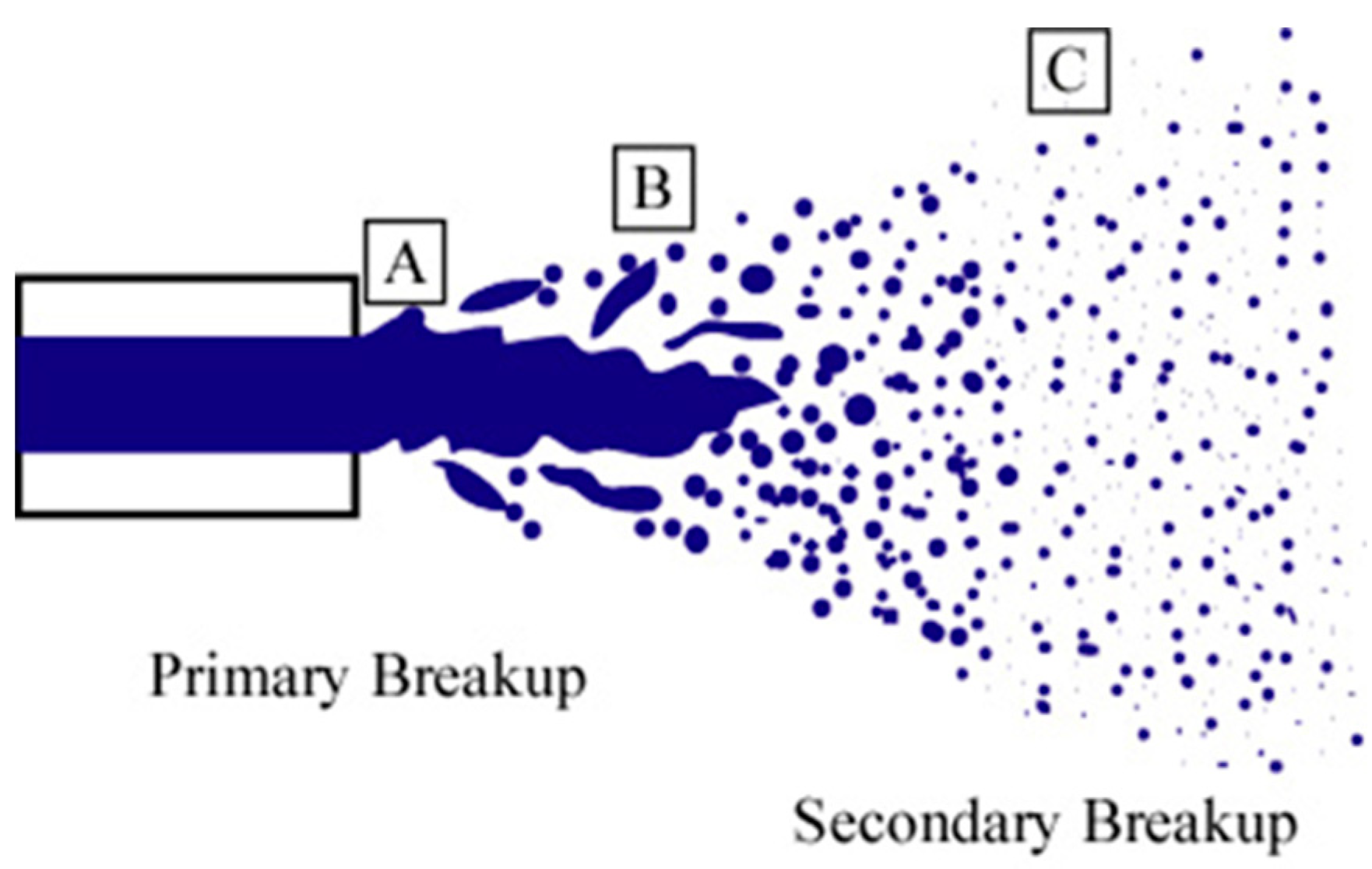
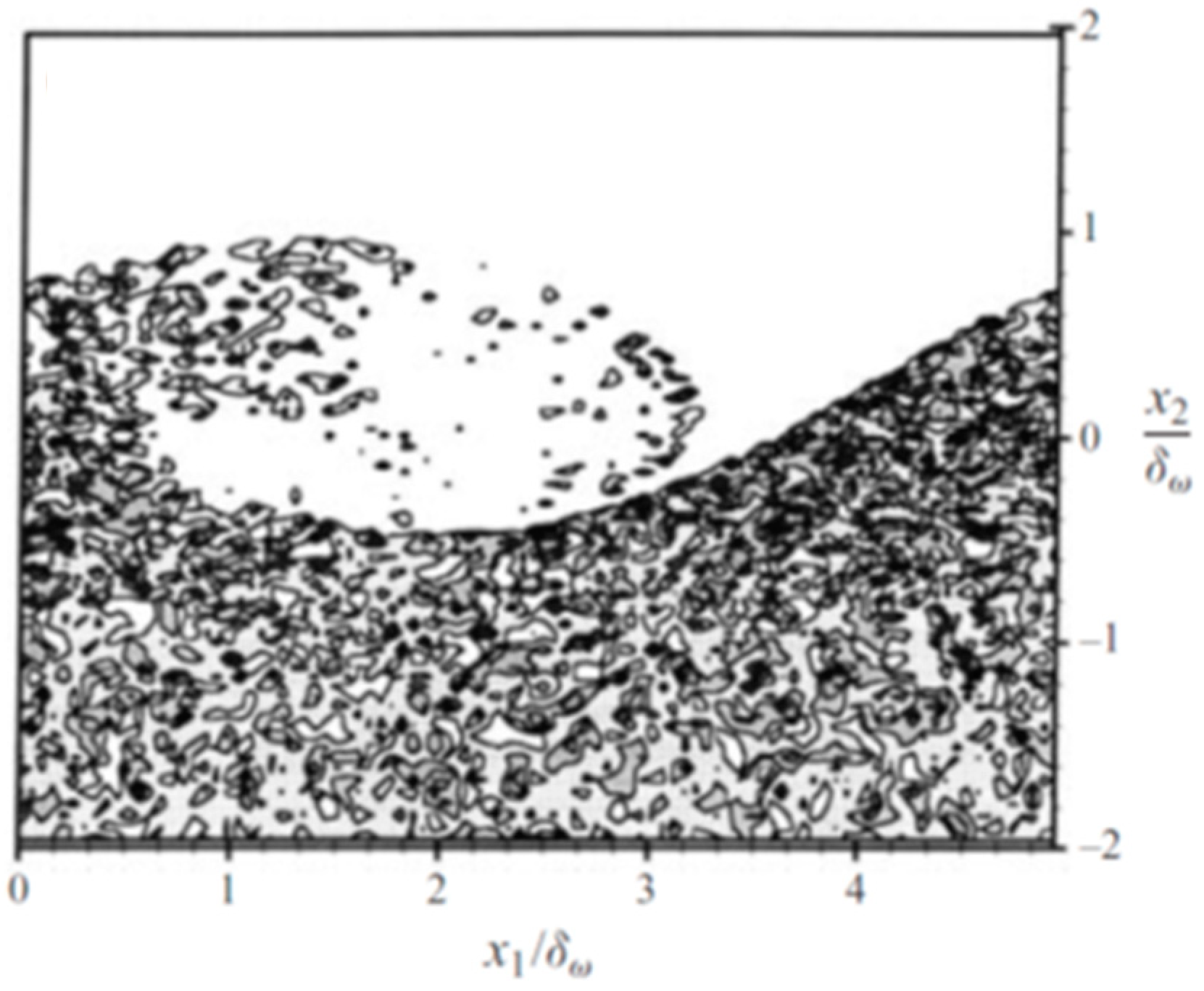
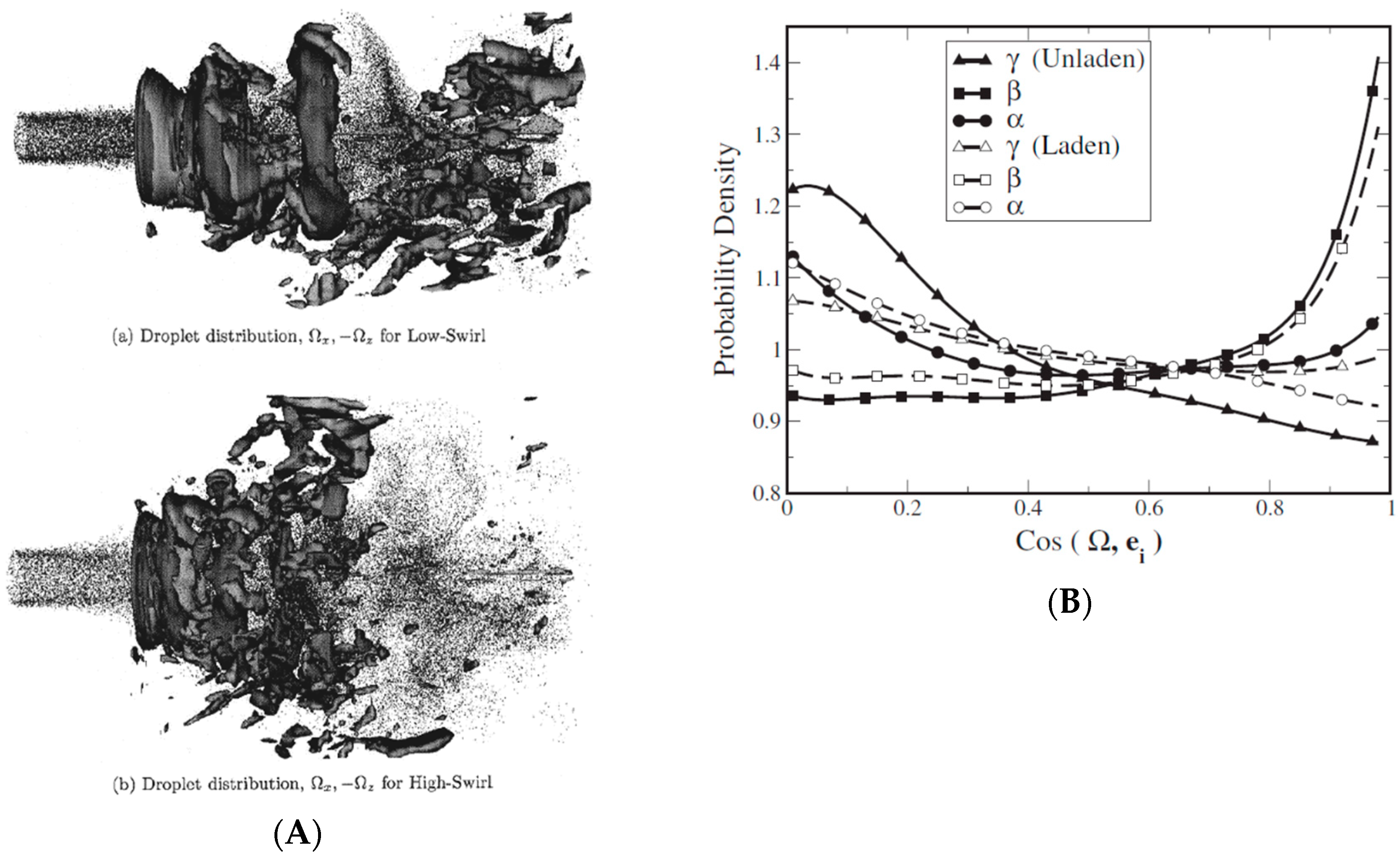
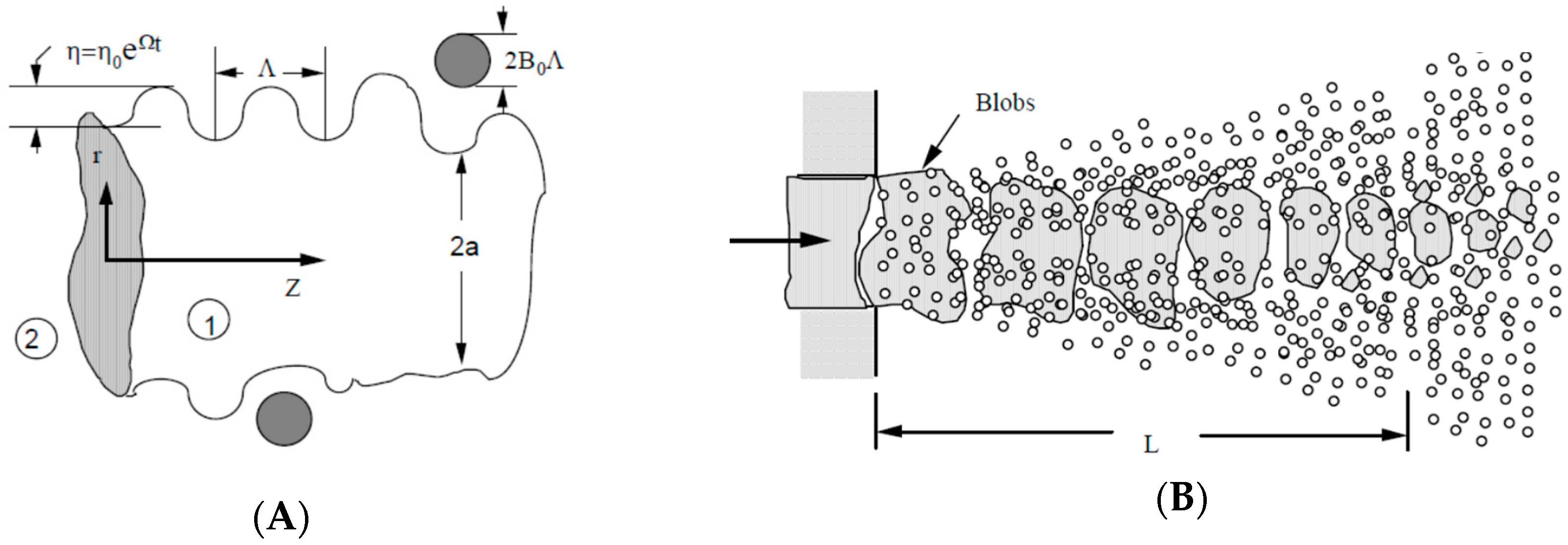
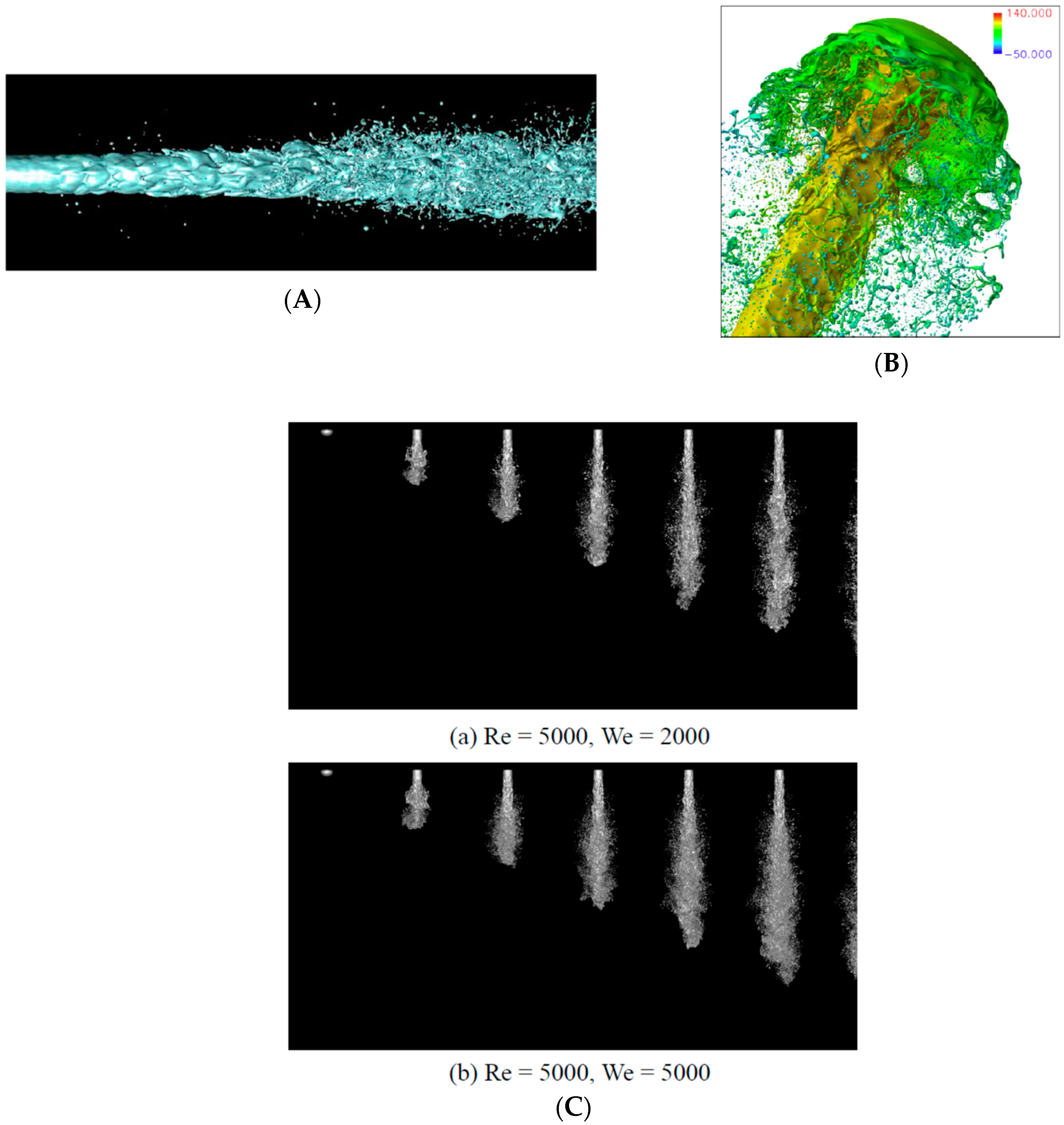

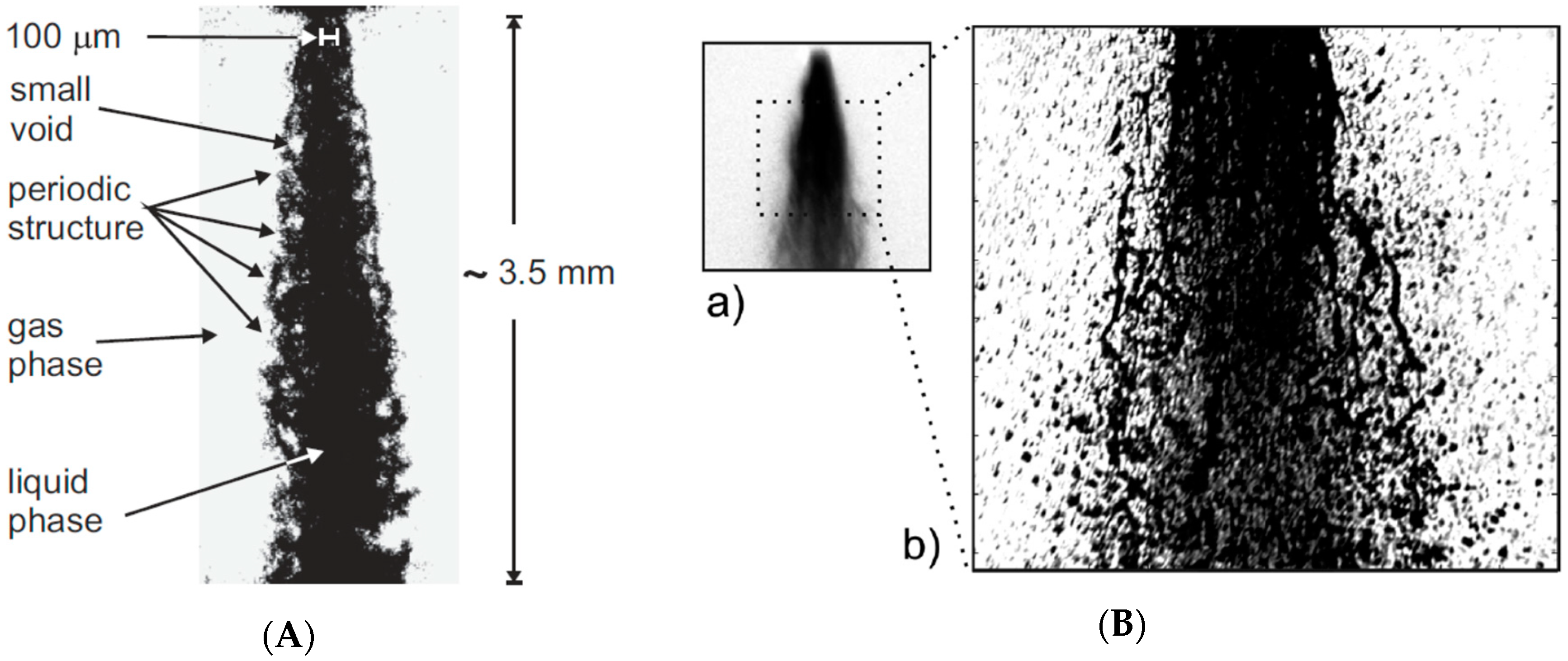
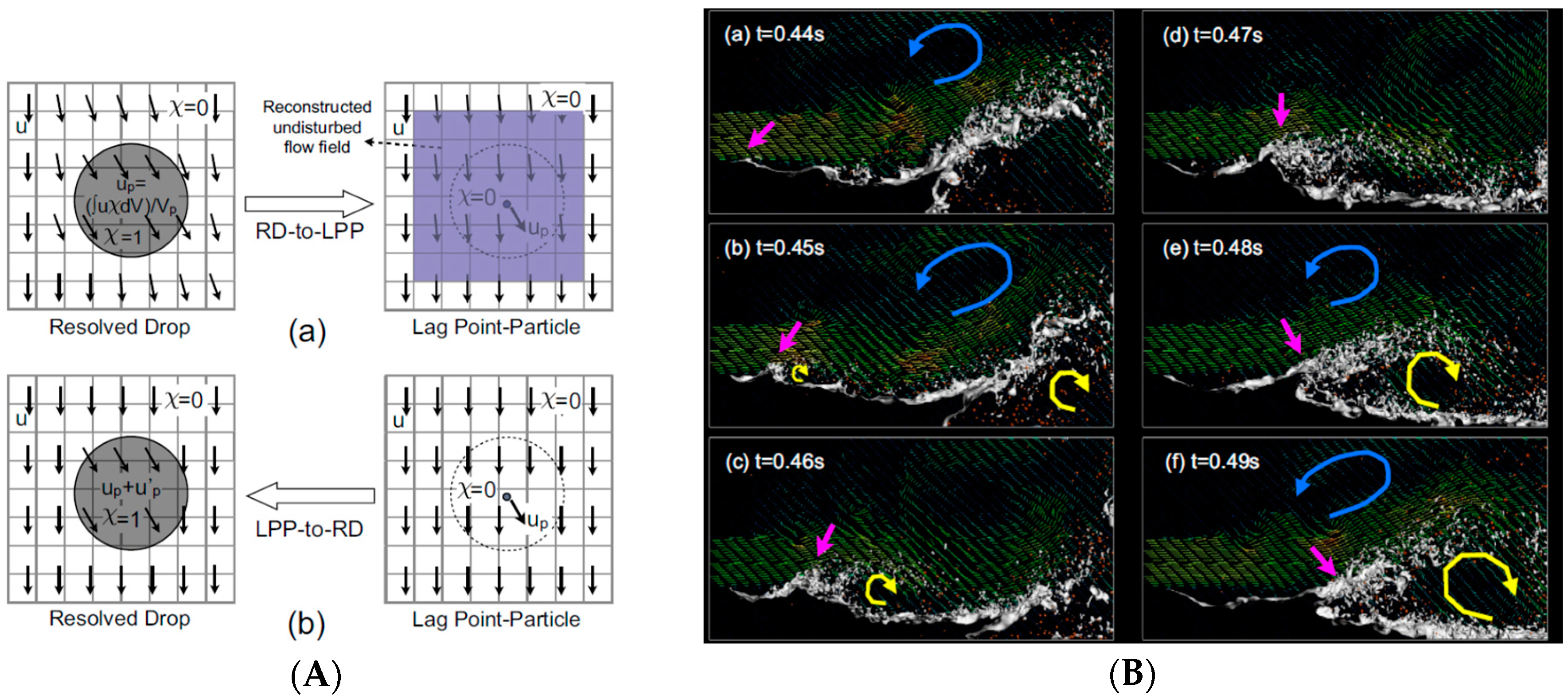
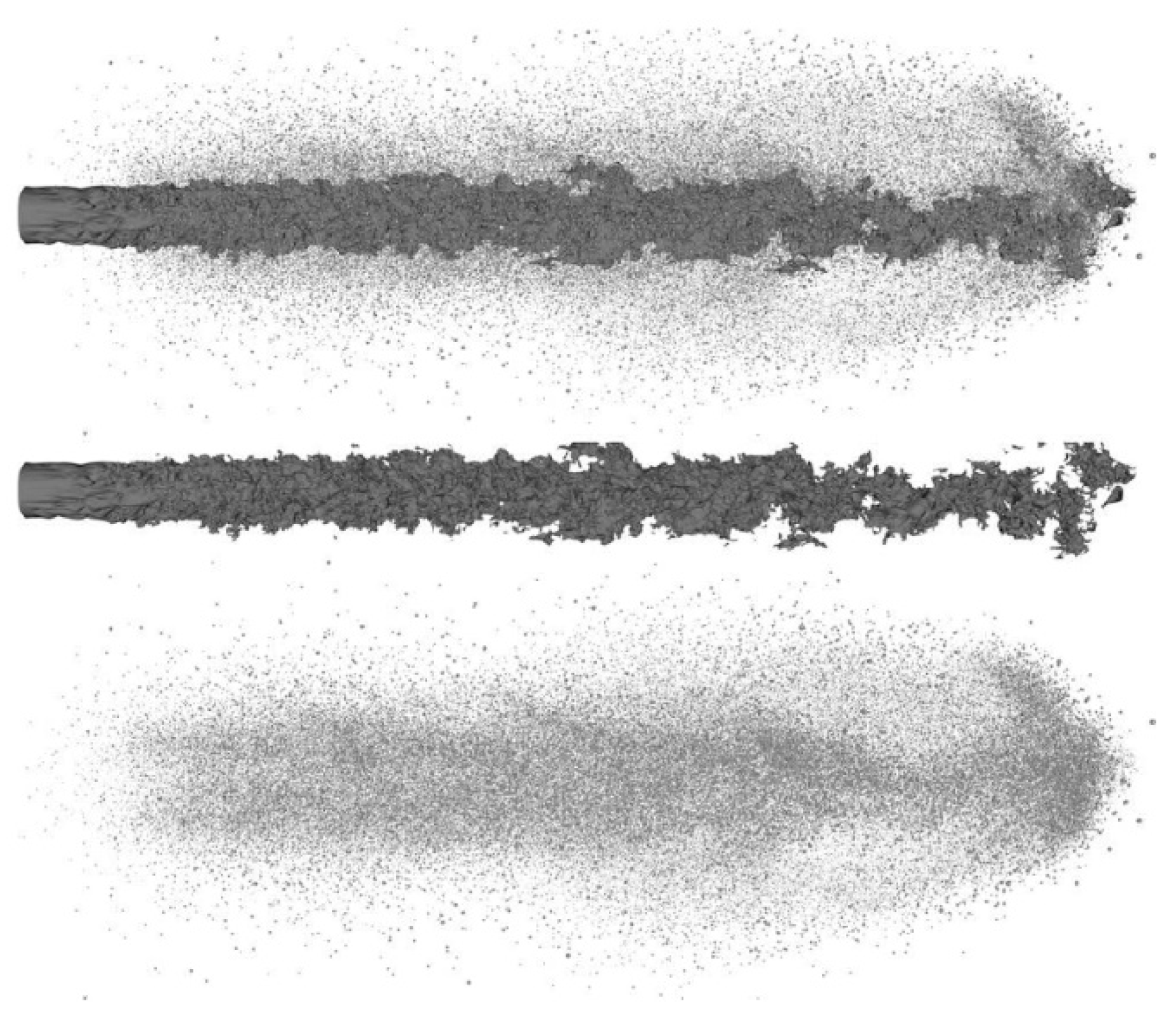
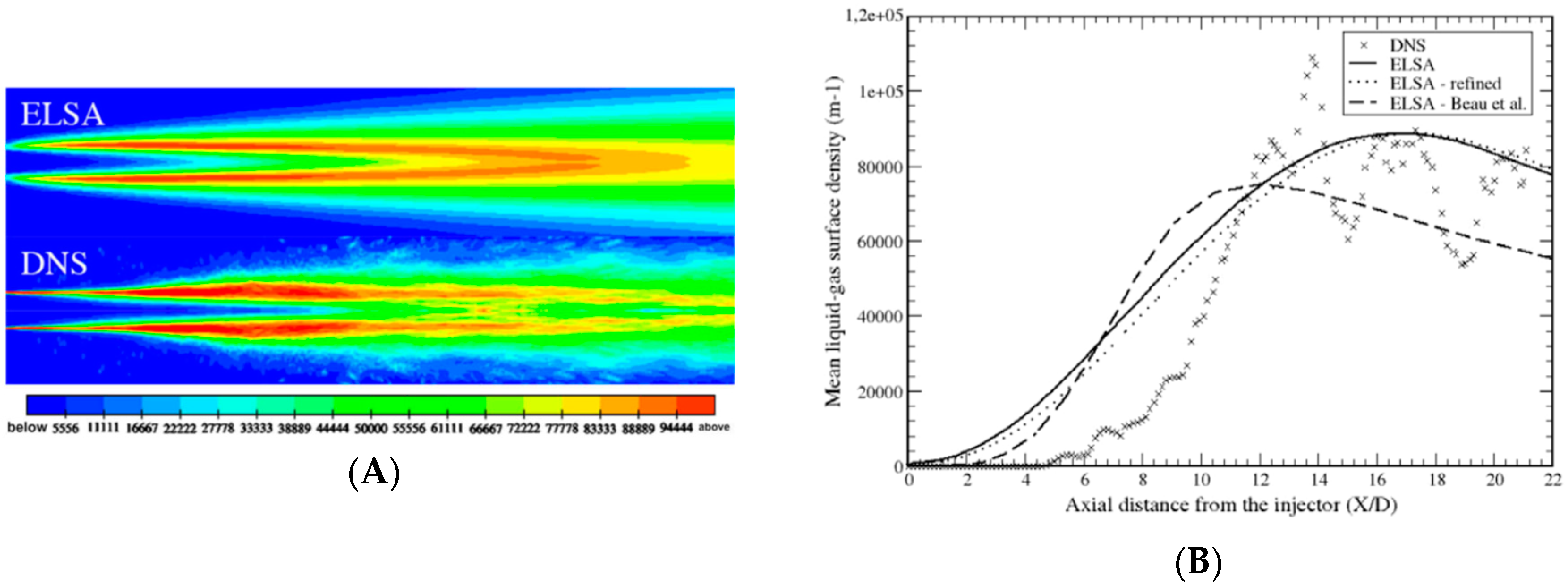
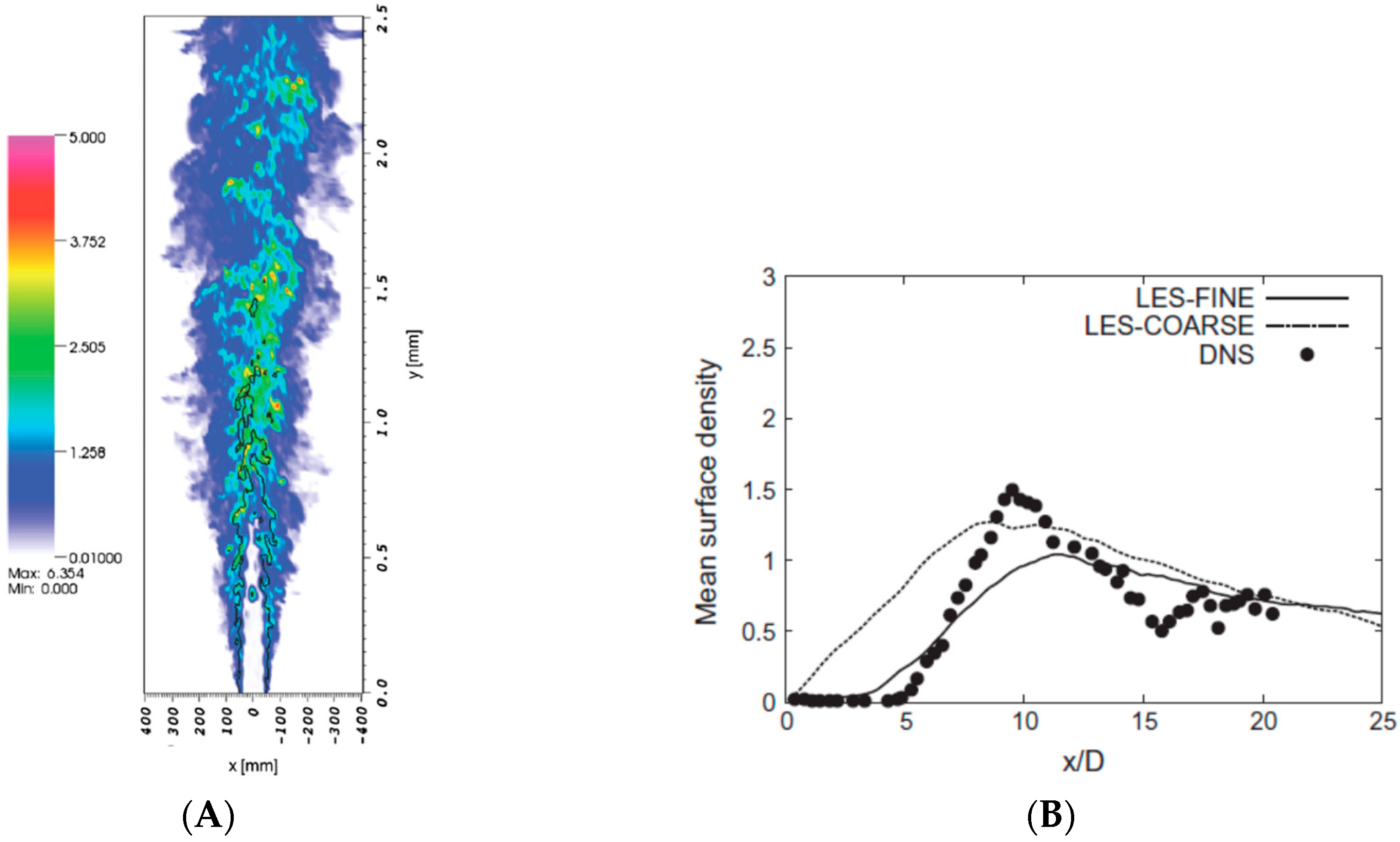
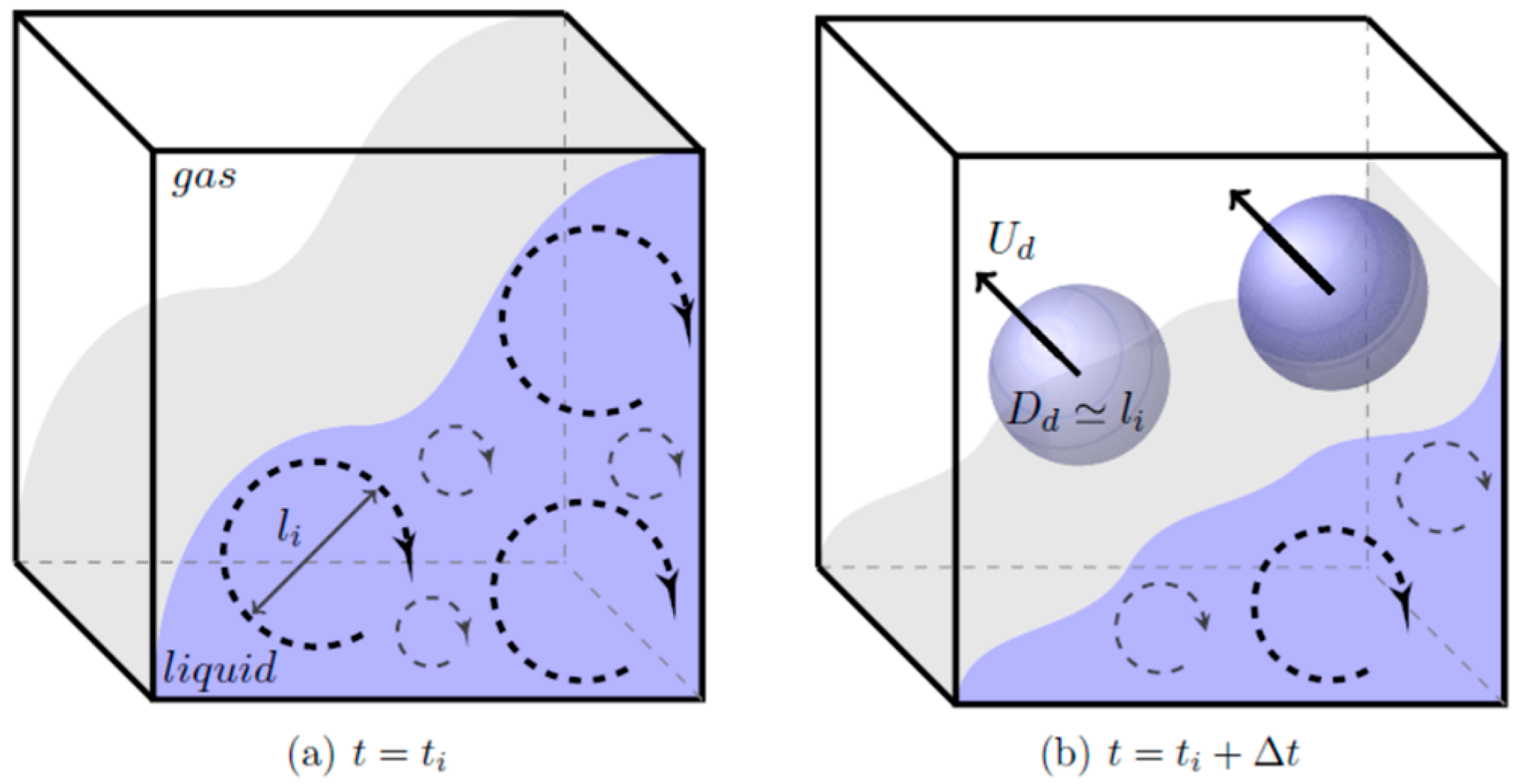
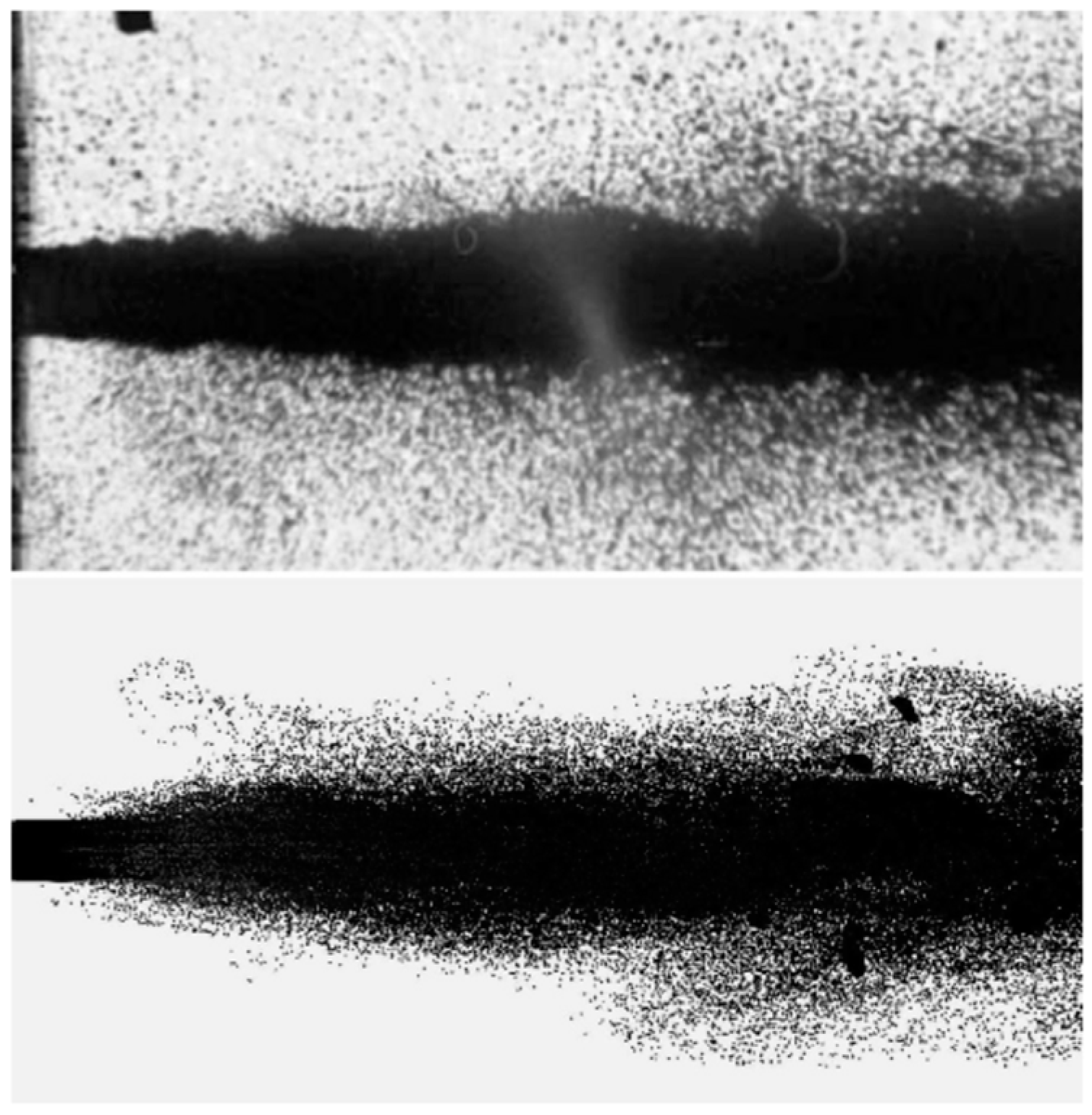
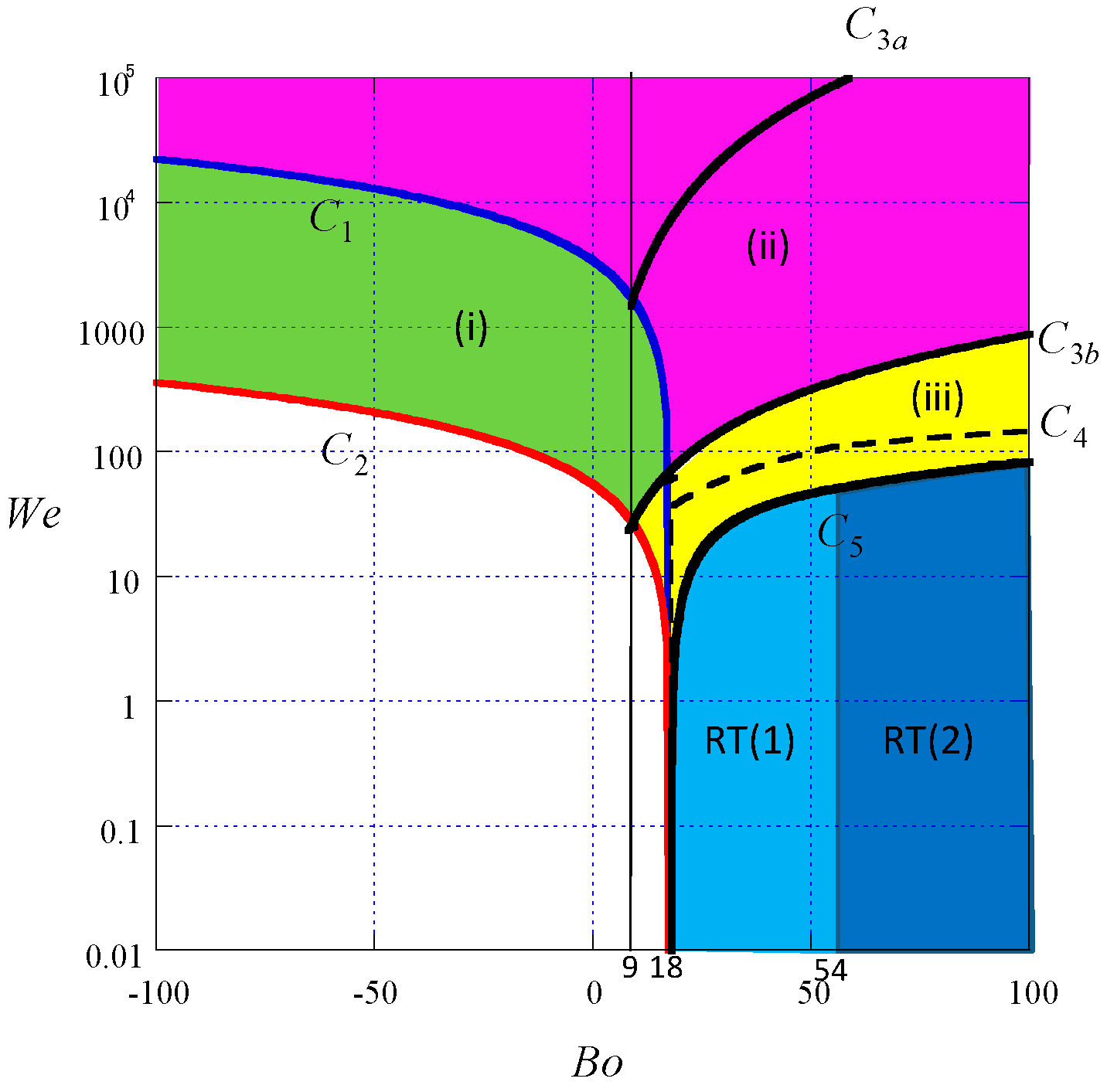
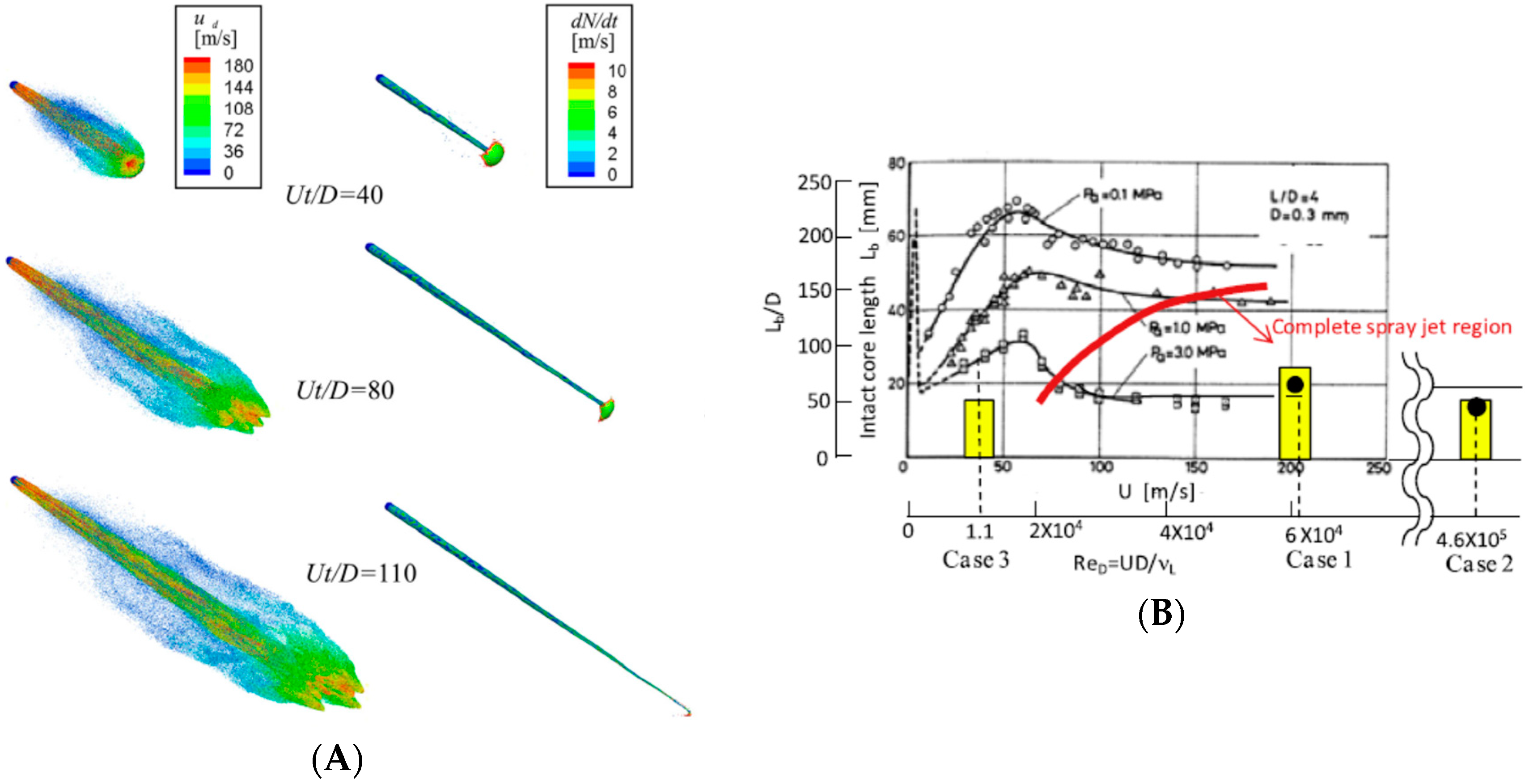
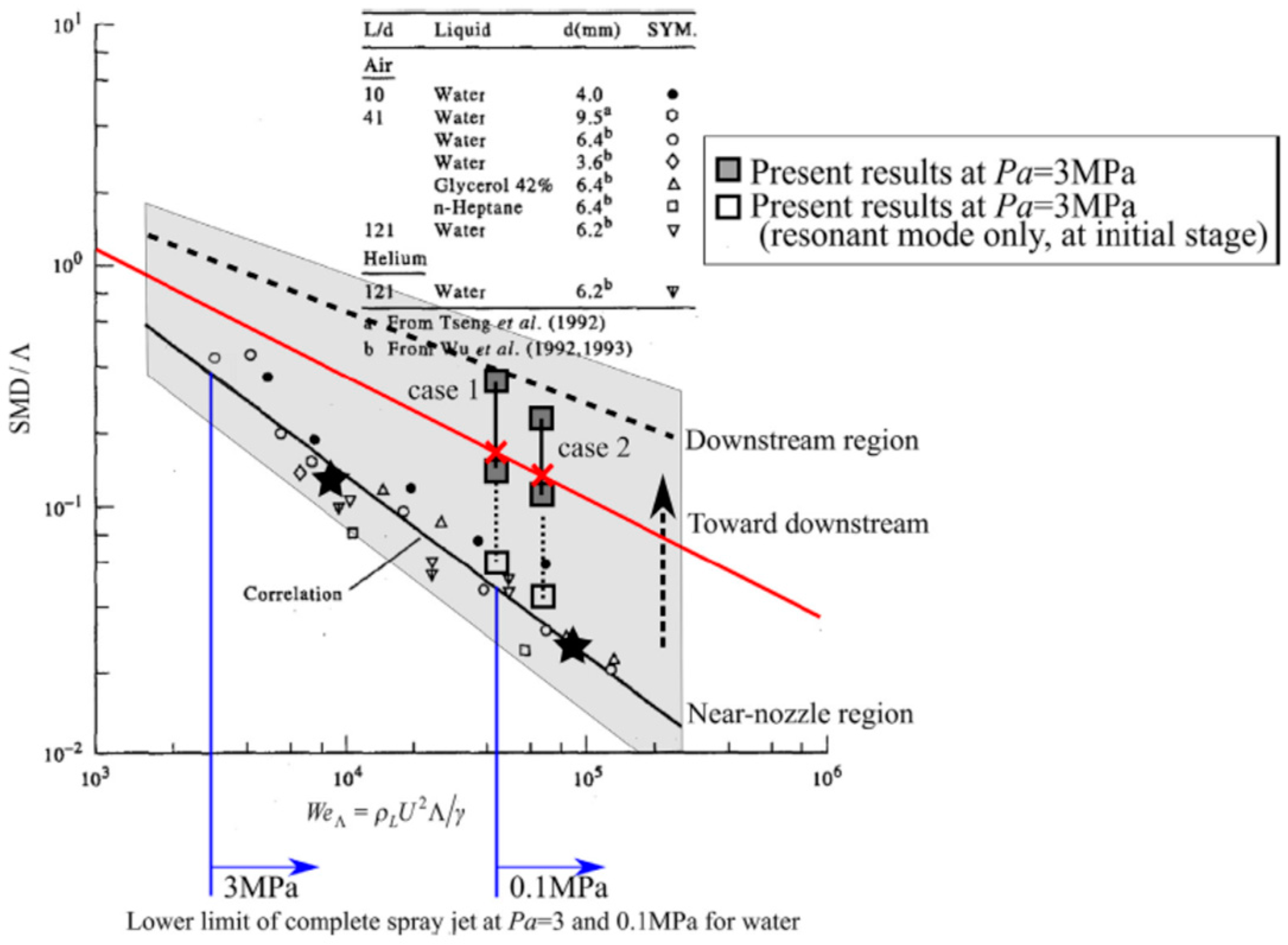

© 2018 by the author. Licensee MDPI, Basel, Switzerland. This article is an open access article distributed under the terms and conditions of the Creative Commons Attribution (CC BY) license (http://creativecommons.org/licenses/by/4.0/).
Share and Cite
Shinjo, J. Recent Advances in Computational Modeling of Primary Atomization of Liquid Fuel Sprays. Energies 2018, 11, 2971. https://doi.org/10.3390/en11112971
Shinjo J. Recent Advances in Computational Modeling of Primary Atomization of Liquid Fuel Sprays. Energies. 2018; 11(11):2971. https://doi.org/10.3390/en11112971
Chicago/Turabian StyleShinjo, Junji. 2018. "Recent Advances in Computational Modeling of Primary Atomization of Liquid Fuel Sprays" Energies 11, no. 11: 2971. https://doi.org/10.3390/en11112971
APA StyleShinjo, J. (2018). Recent Advances in Computational Modeling of Primary Atomization of Liquid Fuel Sprays. Energies, 11(11), 2971. https://doi.org/10.3390/en11112971




